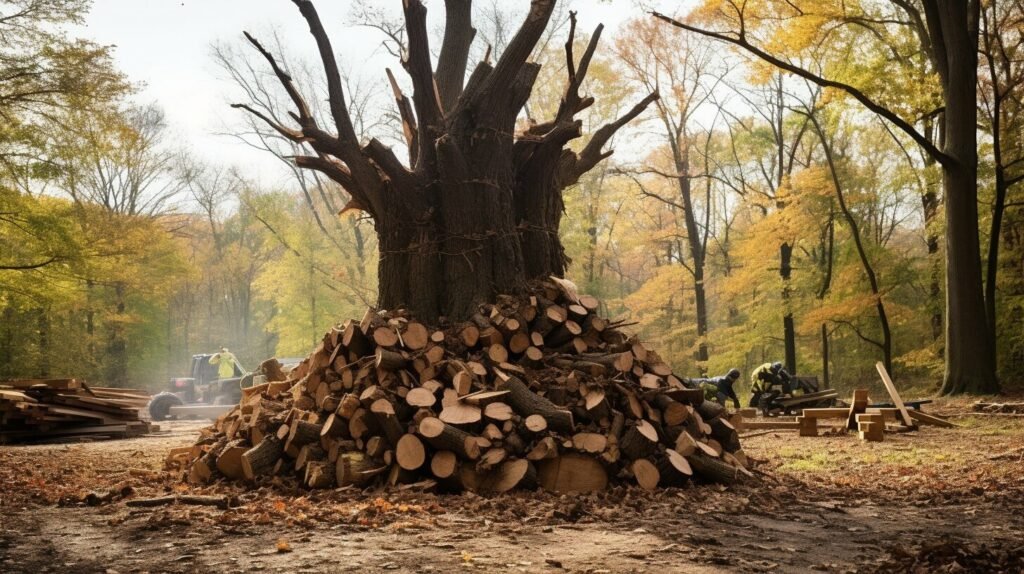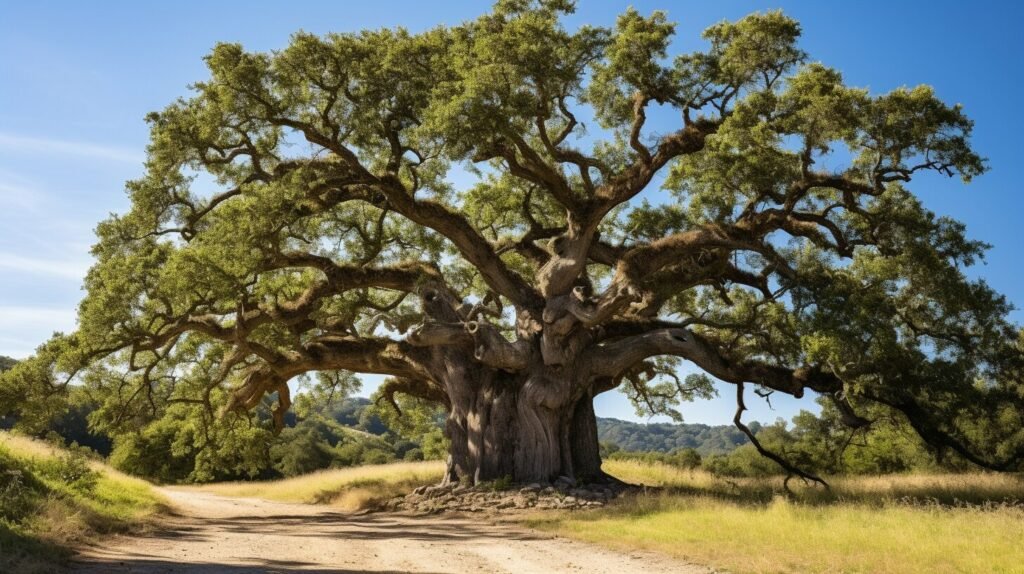Oak tree timber is a versatile and eco-friendly choice for building sustainable structures, offering both strength and aesthetic appeal. As a natural carbon sink, oak timber helps lower CO2 levels, making it a favorable option for green construction. Sourced from well-managed and sustainable forests, oak wood supports responsible harvesting practices that contribute to the socioeconomic well-being of local communities.
- Oak tree timber is a sustainable material for construction, with low environmental impact.
- Its strong structural properties make it ideal for various building purposes.
- Both traditional and contemporary architectural designs can be enhanced by the timeless beauty of oak timber.
- Oak wood is resistant to fungal attacks and has a long lifespan, reducing the need for frequent replacements.
- By choosing oak wood products from reputable sources, consumers can drive demand for sustainable practices in the wood industry.
The Environmental Benefits of Oak Tree Timber
The use of oak tree timber in construction is lauded for its positive impact on the environment, thanks to its low carbon footprint and ability to help lower CO2 levels. Oak timber is a natural carbon sink, absorbing and storing carbon dioxide from the atmosphere. This makes it an excellent choice for sustainable building practices, as it contributes to reducing greenhouse gas emissions and combating climate change.
By using oak tree timber sourced from well-managed and sustainable forests, builders can ensure that their construction projects have minimal environmental impact. Sustainable forestry practices involve selective cutting, which allows for the regeneration of oak trees and promotes biodiversity in surrounding ecosystems. It also supports the socioeconomic well-being of local communities, providing them with livelihoods while preserving natural resources.
“Oak timber is not only eco-friendly but also offers strength and durability, making it an ideal choice for sustainable construction.”
In addition to its environmental friendliness, oak tree timber offers numerous other benefits in construction. Its strength and structural properties make it a reliable choice for builders, ensuring the longevity of the structures. Oak timber has been used for centuries in timber framing, as it provides stability and resilience. Its durability also extends to resistance against fungal attacks, reducing the need for chemical treatments and maintenance. This not only contributes to the eco-friendliness of oak tree timber but also saves costs in the long run.

Moreover, oak tree timber enhances the aesthetic appeal of both traditional and contemporary architectural designs. Its warm and textural qualities create a timeless beauty that adds value to any construction project. Whether it’s a charming rural cottage or a modern urban residence, oak timber effortlessly blends with various design styles.
Environmental Benefits Summary:
- Low carbon footprint and CO2 absorption
- Contributes to sustainable practices and local communities
- Offers strength, durability, and resistance to fungal attacks
- Enhances the aesthetic appeal of structures
| Environmental Benefits of Oak Tree Timber | Summary |
|---|---|
| Low carbon emission | Releases less CO2 into the atmosphere. |
| Carbon sink | Absorbs and stores carbon dioxide, reducing greenhouse gases. |
| Sustainable sourcing | Can be responsibly harvested from well-managed forests. |
| Strength and durability | Ensures long-lasting and resilient structures. |
| Resistance to fungal attacks | Reduces the need for chemical treatments and maintenance. |
| Aesthetic appeal | Enhances the visual appeal of architectural designs. |
Strength and Structural Properties of Oak Tree Timber
Oak tree timber is renowned for its exceptional strength and durability, making it an excellent choice for timber framing and other construction applications. Its dense and tightly packed grain structure gives it incredible load-bearing capabilities, allowing it to withstand heavy weights and resist bending or warping over time. This inherent strength makes oak wood a reliable choice for structural components such as beams, columns, and trusses.
Additionally, oak timber boasts excellent dimensional stability, meaning it is less prone to shrinkage or expansion due to changes in temperature or humidity. This stability is essential in construction, as it ensures the structural integrity and longevity of the building. Oak wood’s resistance to moisture also makes it suitable for outdoor applications, such as decking or exterior cladding, where it can withstand exposure to the elements without compromising its strength.
Oak wood’s resilience and durability have been proven through centuries of use in historic structures, some of which still stand strong today. Its long lifespan reduces the need for frequent replacements, making it a sustainable choice for construction projects.
Moreover, oak timber offers excellent workability, allowing it to be easily shaped, cut, and joined using various construction techniques. This versatility and ease of use contribute to faster and more efficient construction processes, saving both time and labor costs.

In conclusion, the strength, durability, and workability of oak tree timber make it a highly desirable material for timber framing and other construction applications. Its resistance to warping, moisture, and decay ensures the longevity of structures, while its versatility and aesthetic appeal contribute to both traditional and contemporary designs. By opting for oak wood products from reputable sources and supporting responsible harvesting practices, consumers can further promote sustainability in the wood industry.
The Timeless Beauty of Oak Tree Timber
The natural beauty and warm, textural aesthetic of oak tree timber make it a sought-after material for creating visually stunning structures. Whether used in traditional or contemporary designs, oak wood adds a touch of elegance and charm to any architectural project.
With its rich, earthy tones and distinctive grain patterns, oak tree timber brings a sense of warmth and character to interior and exterior spaces. The versatility of oak allows it to be crafted into various shapes, from solid beams to intricate carvings, showcasing its natural beauty and enhancing the overall design.
“The natural beauty and warm, textural aesthetic of oak tree timber make it a sought-after material.”
Not only does oak timber offer visual appeal, but it also possesses excellent durability and longevity. Its dense composition makes it highly resistant to wear and tear, ensuring that structures built with oak wood stand the test of time. Additionally, oak’s natural resistance to fungal attacks eliminates the need for regular maintenance and reduces the risk of structural damage.
By choosing oak tree timber for construction projects, architects, designers, and homeowners can create sustainable and environmentally friendly spaces that showcase the timeless beauty of this remarkable material.

| Advantages of Oak Tree Timber in Design and Construction: |
|---|
| 1. Durable and Long-lasting: Oak wood is known for its exceptional strength and resistance to decay, ensuring structures built with it endure for generations. |
| 2. Warm and Textural Aesthetic: The natural grain and warm hues of oak timber create a visually appealing and inviting atmosphere. |
| 3. Versatility in Design: From classic to modern styles, oak wood can be seamlessly incorporated into various architectural designs, enhancing the overall aesthetic. |
| 4. Environmentally Friendly: Oak is a sustainable material that can be sourced from responsibly managed forests, contributing to a greener planet. |
| 5. Low Carbon Footprint: Oak tree timber acts as a natural carbon sink, absorbing CO2 from the atmosphere and reducing greenhouse gas emissions. |
Durability and Resistance to Fungal Attacks
Oak tree timber boasts impressive durability, as it is naturally resistant to fungal attacks, ensuring a long lifespan and minimal maintenance requirements. This inherent resistance is attributed to the high tannin content present in oak wood, which acts as a natural deterrent to fungi and other wood-decaying organisms. As a result, structures built with oak tree timber are less prone to rot and decay, making them highly durable and suitable for long-term use.
Not only does oak wood possess natural resistance to fungal attacks, but it also has a dense structure, further enhancing its durability. The tightly packed fibers of oak timber make it more resistant to physical damage, such as cracks and dents, compared to other types of wood. This durability ensures that oak tree timber can withstand the test of time, making it an excellent choice for structures that require longevity and minimal maintenance.
Additionally, the resistance of oak tree timber to fungal attacks reduces the need for chemical treatments and preservatives, making it an environmentally friendly choice for construction. By choosing oak wood, builders can contribute to sustainable practices and reduce their reliance on potentially harmful chemicals.

Overall, the durability and resistance to fungal attacks exhibited by oak tree timber make it an excellent choice for sustainable construction. Its natural properties contribute to a long lifespan, reduced maintenance, and decreased reliance on chemical treatments. By utilizing oak wood, builders can create structures that not only stand the test of time but also promote environmental friendliness and sustainability.
Recyclability and Reusability of Oak Tree Timber
Oak tree timber is not only a sustainable choice but also a highly recyclable and reusable material, contributing to ongoing sustainability efforts. Its versatility allows for various applications, ensuring that even after its primary use, oak wood can continue to be repurposed in different ways.
One of the key advantages of oak timber is its ability to be recycled. When oak wood products reach the end of their life cycle, they can be processed and transformed into new materials, reducing waste and the need for raw materials. Recycling oak wood not only reduces the environmental impact but also saves energy compared to the production of new materials.
Furthermore, oak tree timber can also be reused in its original form. This is particularly beneficial when it comes to construction projects, as reclaimed oak wood can be used for flooring, beams, furniture, and other architectural elements. Reusing oak timber not only preserves the characteristics and unique beauty of the wood but also extends its lifespan, reducing the demand for new timber.
Table 1: Examples of Reusing Oak Tree Timber
| Application | Description |
|---|---|
| Furniture | Old oak timber can be transformed into stunning furniture pieces, adding character and warmth to any space. |
| Architectural Features | Reclaimed oak beams and pillars can be used to create unique architectural details in both residential and commercial construction projects. |
| Flooring | Well-preserved oak planks can be repurposed as flooring material, enhancing the aesthetic appeal of any room. |
By embracing the recyclability and reusability of oak timber, we can actively contribute to the preservation of natural resources and reduce waste. Whether it is through recycling or repurposing, oak wood continues to play a significant role in sustainable construction, adding both beauty and environmental benefits to our built environment.

Responsible harvesting practices, such as selective cutting and replanting, ensure the sustainability of oak tree timber supply and support the socioeconomic well-being of local communities. By carefully selecting mature trees for harvesting while leaving younger ones to grow, we can maintain the natural balance of the forest ecosystem. This practice allows the forest to regenerate and thrive, providing future generations with a continuous supply of oak tree timber.
Adhering to responsible harvesting practices not only benefits the environment but also has positive social and economic impacts. Local communities often depend on the forest industry for their livelihoods, and sustainable practices help preserve jobs and support the local economy. By supporting responsible harvesting, we contribute to the well-being of these communities and ensure the long-term sustainability of the oak tree timber industry.
The Benefits of Selective Cutting
Selective cutting is a fundamental aspect of responsible harvesting practices. It involves carefully choosing which trees to remove, considering factors such as age, size, and overall forest health. This approach allows for the removal of mature trees with minimal impact on the surrounding ecosystem, as younger trees are left to continue their growth and play their role in carbon sequestration.

Replanting to Ensure Future Generations
To maintain the sustainability of oak tree timber, replanting is crucial. After selective cutting, new trees are planted to replace the harvested ones. This process ensures that the forest continues to grow and replenish itself, preserving its biodiversity and ecological functions. It also guarantees a constant supply of oak tree timber for future construction needs.
Commitment to Sustainability
At [Company Name], we are committed to sourcing oak tree timber from responsibly managed forests that prioritize sustainable practices. By choosing oak wood products from reputable sources and supporting companies that uphold responsible harvesting practices, consumers can drive the demand for environmentally friendly practices in the wood industry. Together, we can contribute to a more sustainable future, where the beauty and benefits of oak tree timber can be enjoyed for generations to come.
Driving Demand for Sustainable Practices in the Wood Industry
By selecting oak tree timber products from reputable sources and promoting environmentally friendly practices, consumers play a vital role in driving demand for sustainability in the wood industry. Oak timber is renowned for its environmental friendliness and low carbon footprint, making it a popular choice for sustainable construction.
One of the key advantages of oak timber is its status as a natural carbon sink. As oak trees grow, they absorb CO2 from the atmosphere, helping to lower carbon emissions. This makes oak a highly sustainable building material, as it actively contributes to mitigating the effects of climate change.
When sourced from well-managed and sustainable forests, oak timber ensures the longevity of natural resources and protects biodiversity. Responsible harvesting practices such as selective cutting and replanting are essential to maintain the sustainability of oak wood supply. These practices not only safeguard the environment but also contribute to the socioeconomic well-being of local communities.
Furthermore, oak timber offers practical and aesthetic benefits. Its strong structural properties make it suitable for various construction purposes, and it can be used in both traditional and contemporary designs. Oak wood creates a warm and textural aesthetic that enhances the overall beauty and appeal of structures.

Additionally, oak wood is highly durable and resistant to fungal attacks, ensuring its longevity and reducing the need for frequent replacements. This not only saves costs but also minimizes waste in construction projects.
Moreover, oak timber is recyclable and reusable, contributing to sustainability efforts. By repurposing oak wood products, we minimize our environmental impact and create a circular economy, reducing the demand for virgin materials.
As consumers, we have the power to drive demand for environmentally friendly practices in the wood industry. By choosing oak tree timber from reputable sources and supporting sustainable practices, we can prioritize the preservation of our planet and leave a positive impact on future generations.
Conclusion
Oak tree timber is undeniably an invaluable resource for sustainable construction, offering strength, beauty, and environmental benefits that contribute to a greener and more responsible future. As a natural carbon sink, oak timber helps lower CO2 levels and can be sourced from well-managed and sustainable forests. Its quick and efficient buildability, combined with its strong structural properties, make it an ideal choice for various construction purposes.
Not only does oak wood possess timeless beauty that enhances both traditional and contemporary designs, but it also exhibits exceptional durability. Resistant to fungal attacks, oak timber has a long lifespan, reducing the need for frequent replacements and minimizing waste. Furthermore, its recyclability and reusability further contribute to sustainability efforts, making it an eco-friendly option for construction projects.
Responsible harvesting practices, including selective cutting and replanting, ensure the sustainability of oak wood supply and support the socioeconomic well-being of local communities. By choosing oak wood products from reputable sources and supporting sustainable practices, consumers play a vital role in driving demand for environmentally friendly practices in the wood industry. Together, we can create a more sustainable future through the use of oak tree timber in green construction.
FAQ
Is oak timber a sustainable choice for construction?
Yes, oak timber is a popular choice for sustainable construction due to its environmental friendliness and low carbon footprint. It can be sourced from well-managed and sustainable forests, and is a natural carbon sink, lowering CO2 levels.
What are the structural properties of oak timber?
Oak timber has strong structural properties, making it quick and efficient to build with. It can be used in both traditional and contemporary designs, creating a warm and textural aesthetic.
Is oak wood durable?
Yes, oak wood is highly durable and resistant to fungal attacks. It has a long lifespan, reducing the need for frequent replacements.
Can oak wood be recycled and reused?
Absolutely! Oak wood can be recycled and reused, contributing to sustainability efforts and minimizing waste.
Are there responsible harvesting practices for oak timber?
Yes, responsible harvesting practices such as selective cutting and replanting ensure the sustainability of oak wood supply and contribute to the socioeconomic well-being of local communities.
How can consumers drive demand for environmentally friendly practices in the wood industry?
By choosing oak wood products from reputable sources and supporting sustainable practices, consumers can drive demand for environmentally friendly practices in the wood industry.




